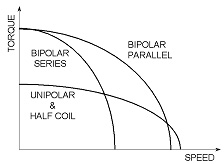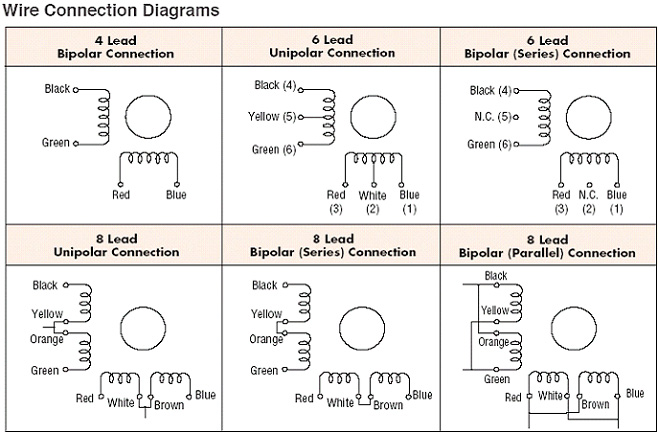Unipolar / Bipolar Connections for 2-Phase Stepper Motors
| Connections | Resistance (Ohms) |
Inductance (mH) | Current (A) | Voltage (V) | Holding Torque (oz-in) |
|---|---|---|---|---|---|
| Unipolar | Same as Catalog |
Same as Catalog |
Same as Catalog |
Same as Catalog |
Same as Catalog |
| Bipolar Series | Catalog X 2 | Catalog X 4 | Catalog X 0.707 |
Catalog X 1.414 |
Catalog X 1.414 |
| Bipolar Half Coil | Same as Catalog |
Same as Catalog |
Same as Catalog |
Same as Catalog |
Same as Catalog |
| Bipolar Parallel | Catalog X 0.5 | Same as Catalog |
Catalog X 1.414 |
Catalog X 0.707 |
Catalog X 1.414 |
| Customer's Driver | Motor Choices |
What to Do | How to Do It | End Result | |
|---|---|---|---|---|---|
| Unipolar (6 Leads) |
6 Lead Motor | Use as is Unipolar |
|
6 Leads | |
| 8 Lead Motor | Convert to Unipolar |
Tie yellow and orange together and use AND Tie white and brown together and use |
6 Leads | ||
| Bipolar (4 Leads) |
6 Lead Motor | Convert to Series |
Tape off yellow and white leads and don't use | 4 Leads | |
| Convert to Half Coil | Tape off black and red leads OR | 4 Leads | |||
| Tape off green and blue leads | |||||
| 8 Lead Motor | Convert to Series |
Connect yellow and orange and tape off AND Connect white and brown and tape off |
4 Leads | ||
| Convert to Parallel |
Tie black and orange together AND Tie yellow and green together AND Tie red and brown together AND Tie white and blue together |
4 Leads | |||
| Convert to Half Coil | Tape off black, yellow, red, and white OR |
4 Leads | |||
| Tape off orange, green, brown, and blue | |||||
Unipolar and Bipolar Half Coil, because we're using less turns, doesn't give us great low speed torque, but because of the low inductance, holds the torque out to high speeds.
Bipolar Series uses the full coil so it gives very good low speed torque. But because of the high inductance, the torque drops off rapidly.
Bipolar Parallel also uses the full coil so it gives good low speed performance. And its low inductance allows the torque to be held out to high speeds. But remember, we must increase current by 40% to get those advantages.

